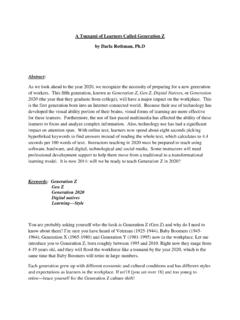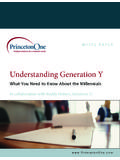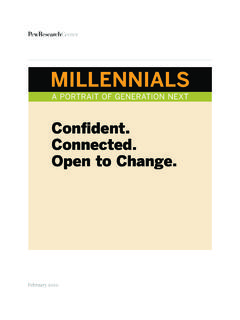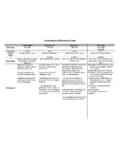Transcription of Marketing to the Generations
1 Journal of Behavioral Studies in Business Marketing to the Generations , Page 1 Marketing to the Generations Kaylene C. Williams California State University, Stanislaus Robert A. Page Southern Connecticut State University ABSTRACT Each generation has unique expectations, experiences, generational history, lifestyles, values, and demographics that influence their buying behaviors. Accordingly, many companies are reaching out to multi-generational consumers and trying to understand and gain the attention of these diverse buyers. Multi-generational Marketing is the practice of appealing to the unique needs and behaviors of individuals within more than one specific generational group, with a generation being a group of individuals born and living about the same time [1].
2 This means that marketers need to understand the six Generations : Pre-Depression generation , Depression generation , Baby Boomers, generation X, generation Y, and generation Z. When a marketer factors in the different characteristics and behaviors of the Generations , it should be easier to build relationships, gain trust, and close business. [2, 3] As such, an understanding of multi-generational Marketing is very important to the marketer. The purpose of this paper is to describe briefly the Generations in terms of the times in which they grew up as well as the characteristics, lifestyles, and attitudes of the group.
3 However, the primary focus of the paper is to describe various Marketing understandings and strategies appropriate to each generation s characteristics and behaviors, particularly in terms of segmentation, products and services, and communication. Keywords: Multigenerational Marketing , Generations , Baby Boomers, Xers, Gen Y, generation Z Journal of Behavioral Studies in Business Marketing to the Generations , Page 2 INTRODUCTION Not every generation is alike, nor should they be treated by marketers in the same way. Multi-generational Marketing is the practice of appealing to the unique needs and behaviors of individuals within more than one specific generational group, with a generation being a group of individuals born and living about the same time [1].
4 When a marketer factors in the different characteristics and behaviors of the Generations , it should be easier to build relationships, gain trust, and close business [2]. In fact, creating ageless multi-generational brands is one of the top ten Marketing trends over the next 25 years [4]. As such, an understanding of multi-generational Marketing is very important to the marketer. [3] The purpose of this paper is to describe briefly the various Generations in terms of the times in which they grew up as well as the characteristics, lifestyles, and attitudes of the group. However, the primary focus of the paper is to describe how to create various Marketing strategies appropriate to each generation s characteristics and behaviors, particularly in terms of segmentation, products and services, and communication.
5 THE Generations A generation or age cohort is a group of persons who travel through life together and experience similar events at a similar age. That is, they share a common social, political, historical, and economic environment. While there is some inconsistency with regard to detail, an examination of written materials regarding the Generations indicates that there are six American Generations : Pre-Depression, Depression, Baby Boom, generation X, generation Y, and generation Z. [5, 6, 7, 8, 9, 10, 11, 12] Table 1 lists information specific to each of these Generations , , date of birth, number of individuals, and age as of 2010.
6 Each of these Generations is described in essence below with regard to the times in which they grew up and to their characteristics, lifestyles, and attitudes. Thereafter, each generation is described in terms of how to market to that specific generation with a particular focus on segmentation, products and services, and communication. Marketing TO THE PRE-DEPRESSION generation The Pre-Depression generation ( generation , Veteran generation , and WWI generation ) was born before 1930 and are 81 and above as of 2010. Most were children during the Depression experiencing traumatic times, economic strife, and elevated unemployment rates.
7 As young adults during WWII, their lives began with high expectations, which were shattered eventually by WWI and WWII. The Pre-Depression generation has witnessed radical social and technological changes including glistening new schools, miracle medicines, and launched rockets. [7, 5] In terms of their characteristics, lifestyles, and attitudes, members of the Pre-Depression generation are conservative, altruistic, and become less materialistic as they age. They are concerned about health, aging, financial and personal security, and the disposition of valued belongings. [13, 14, 15, 8, 16, 17, 18] With regard to effective Marketing strategies for the Pre-Depression generation , the most important segmentation variables are health, activity level, discretionary time, engagement in society, and gender.
8 As much as possible, they have adopted young again lifestyles and attitudes. While they are somewhat sedentary, they watch a lot of television and walking is their main source of exercise. They are very concerned about the disposition of their valued belongings. Security rules their thinking, for example, it is good to contact them through professional advisors such as lawyers and financial managers. [19, 11] Important products and services include vacations, health services, and single-serving size prepared foods. Because they are concerned about their health and aging, important products and services are nursing or retirement homes and assisted-living services.
9 This is increasingly important as men live to be an average of 79 and women 83, but half of those over 80 suffer from a long-term illness. [20, 10, 11, 12] In terms of communication, the Pre-Depression generation prefers print media for information. They read newspapers, magazines, and ads more thoroughly than other Generations . For the mature market in general, communicating often requires alteration of messages and materials, that is, larger type with clear, bright pictures, newspapers, AM radio, models they can relate to, and simple language. It is very effective to use action to attract attention while keeping the word count low and reducing extraneous stimuli.
10 Rather than appealing to their chronological age, it is important to communicate to their cognitive age or the age a person perceives himself or herself to be. In particular, cognitive age can be used for targeting segments within this group, developing more creative content, and selecting more effective media. In addition, face-to-face communication and personal service are valued by this generation , few use the Internet. Marketers can get in touch with this group through their children as well as talking to them at formal social gatherings and recognition events. [21, 20, 22] Marketing TO THE DEPRESSION generation The Depression generation ( Silent generation , Traditionalists, and Swing generation ) was born during 1930-1945 and are in the 65-80 age range as of 2010.














